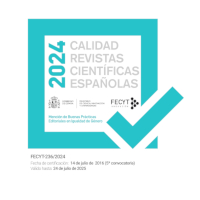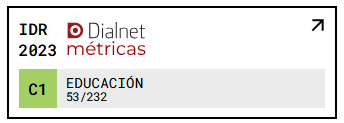Estudiantes para maestros : reflexiones sobre la instrucción en los números racionales positivos
DOI:
https://doi.org/10.18172/con.538Keywords:
Learning, mathematics, higher education, university studentAbstract
Future Primary Education teachers find it extremely difficult to understand rational numbers. The difficulties they have to face are mainly due to a previous learning process, a process which used to consider better to learn the meaning of fractions as being related to the part and the whole. The first part of this paper is focused on the study of such difficulties and also on the special characteristics of the knowledge adquired by these future teachers. In the second part alternative methods are proposed in order to help these future teachers to overcome the above mentioned difficulties: Working with a measure model allows them to re-elaborate their knowledge of the positive rational number system, whereas working with a quotient model allows them to reinforce the connections between fraction and decimal notations.Downloads
References
BALL, D.L. (1993) Halves, pieces, and twoths: constructing and using representational contexts in teaching fractions. En CARPENTER, T. P.; FENNEMA, E. y ROMBERG, T. A. (eds.). Rational Numbers. An integration of Research. Hilldale, N. J.: Lawrence Erlbaum Associates Publishers.
BOYER, C.B. (1986) Historia de la Matemática. Madrid: Alianza Editorial.
BROUSSEAU, G. (1993) Problemas en la enseñanza de los decimales. Problemas de didáctica de los decimales. Córdoba, Argentina: Universidad de Córdoba.
BROWN, C.A. (1993) A critical analysis of teaching rational number. En CARPENTER, T. P.; FENNEMA, E. y ROMBERG, T. A. (eds.): Rational Numbers. An integration of Research. Hilldale, N. J.: Lawrence Erlbaum Associates Publishers.
CASTRO, E.; RICO, L. y ROMERO, I. (1997): Sistemas de representación y aprendizaje de estructuras numéricas. Enseñanza de las Ciencias, 15 (3), 361-371.
ESCOLANO, R. y GAIRÍN, J.M. (2004) Los modelos de medida en la enseñanza del número racional positivo en Educación Primaria: una propuesta alternativa a la relación parte-todo. En DEPARTAMENTO DE DIDÁCTICA DE LAS MATEMÁTICAS: Homenaje al profesor Jorge Cázares. Universidad de Granada (Pendiente de publicación).
GAGATSIS, A. y PATRONIS, T. (1990) Using Geometrical models in a process of reflective thinking in learning and teaching mathematics. Educational Studies in Mathematics, 21, 29-54.
GAIRÍN, J.M. (1999) Sistemas de representación de números racionales positivos. Un estudio con Maestros en formación. Tesis Doctoral, Universidad de Zaragoza.
GAIRÍN, J.M. (2001a) Modelos y significados. Conferencia pronunciada en los Cursos de Verano de El Escorial.
GAIRÍN, J.M. (2001b) Sistemas de representación de números racionales positivos: un estudio con maestros en formación. Contextos educativos, 4,137-159.
GIMÉNEZ, J. (1991) Innovación metodológica de la didáctica especial del número racional positivo. Diagnosis cognitiva y desarrollo metodológico. Tesis doctoral, Universidad Autónoma de Barcelona.
HIEBERT, J.A. (1993) Benefits and costs of research that links teaching and learning mathematics. En CARPENTER, T.P.; FENNEMA, E. y ROMBERG, T.A. (eds.). Rational Numbers. An integration of Research. Hilldale, N. J.: Lawrence Erlbaum Associates Publishers.
KERSLAKE, D. (1986) Fractions: Children´s strategies and errors. Windsor, England: NFER-NELSON.
KIEREN, T.E. (1993) Rational and Fractional Numbers: From Quotient Fields to Recursive Understanding”. En CARPENTER, T. P.; FENNEMA, E. y ROMBERG, T. A. (eds.). Rational Numbers. An integration of Research. Hilldale, N. J.: Lawrence Erlbaum Associates Publishers.
LESH, R. (1997) Matematización: La necesidad “real” de la fluidez en las representaciones. Enseñanza de las Ciencias, 15 (3), 377-391.
LESH, R.; POST, T. y BEHR, M. (1987) Representacions and translation among representation en Mathematics learning and Problem Solving. En JANVIER, C. (eds.). Problems of Representation in the teaching and learning of Mathematics. Hilldale, N. J.: LEA.
LLINARES, S. y SÁNCHEZ, M.V. (1996) Comprensión de las nociones matemáticas y modos de representación. El caso de los números racionales para profesores de Primaria. En GIMÉNEZ, J.; LLINARES, S. y SÁNCHEZ, M.V. (eds.). El proceso de llegar a ser profesor de primaria. Cuestiones desde la educación matemática. Granada: Colección Mathema.
LLINARES, S.; SÁNCHEZ, M.V. y GARCÍA, M. (1994) Conocimiento de Contenido Pedagógico del Profesor. Tareas y modos de representación para las fracciones. Revista de Educación, 304, 199-225.
MARCK, N.K. (1995) Confounding Whole-Number and Fraction Concepts When Building on Informal Knowledge. Journal for Research in Mathematics Education, 26 (5), 422-441.
NATIONAL COUNCIL OF TECHERS OF N.C.T.M. (1989) Curriculum and evaluation standars for school mathematics. Reston, Virginia.
NATIONAL RESEARCH COUNCIL (1989) Everybody Counts: A report to the nation on the future of Mathematics education. Washington: National Academic Press.
NOVILLIS-LARSON, C. (1980) Locating proper fraction on number lines: Effect of length and equivalence. School Science and Mathematics, 53(5), 423-428.
OWENS, D.T. y SUPER, D.B., (1993) Teaching and Learning Decimal Fractions. En OWENS, D. (eds.): Research ideas for the classroom. Middle grades mathematics. Reston, Virginia: National Council of Teachers of Mathematics.
PHILIPPOU, G. y CHRISTOU, C. (1994) Prospective elementary Teachers’Conceptual and Procedural Knowledge of Fractions. En Proceedings XVIII PME. Lisboa, Portugal.
PINTO, M. y TALL, D. (1996) Student teachers´conceptions of the rational numbe”. Proceedings XX PME. Valencia, España.
POST, T.R.; HAREL, G.; BEHR, M.J. y LESH, R. (1991) Intermediate teachers’knowledge of rational number concept. En FENNEMA, E.; CARPENTER, T.P. y LAMON, S.J. (eds.). Integrating research on teaching and learning mathematics. Albany, New York: SUNY.
RESNICK, L.B.; NESHER, P.; LEONARD, F.; MAGONE, M.; OMANSON, S. y PELED, I. (1989) Conceptual bases of artihmetic errors: the case of decimal fracctions. Journal for Research in Mathematics Education, 20, 8-27.
SÁNCHEZ VIDAL, B. (1866): Lecciones de aritmetica. Madrid, Imprenta de F.
Martínez García.
SCARDAMALIA, M.; BEREITER, C.; MCLEAN, R.S.; SWALOW J. y WOODRUFF, E. (1989) Computer-supported intentional learning enviroments. Journal of Educational Computing Research, 5 (1), 51-68.
SIMON, M. (1993) “Prospective elementary Teachers´ Kowledge of división”. Journal for Research in Mathematics Education, 24 (3), 233-254.
SOWDER J.T. (1995) Instructing for rational number sense. En SOWDER, J.T. y SHAPPELLE, B.P. (eds.). Providing a Foundation for Teaching Mathematics in the Middle Grades. New York: State University of New York Press.
SOWDER, J.T.; BEZUK, N. y SOWDER, L.K. (1993) Using principles from cognitive
psychology to guide rational number instruction for prospective teachers. En CARPENTER, T. P., FENNEMA, E. y ROMBERG, T. A. (eds.). Rational Numbers. An integration of Research. Hilldale, N. J.: Lawrence Erlbaum Associates Publishers.
SOWDER, J.T.; PHILIPP, R.A.; FLORES, A. y SCHAPPELLE, B.P. (1995) Instructional effects of kowledge of and about mathematics. a case study. En SOWDER, J.T. y SCHAPPLLE, B.P. (eds.). Providing a Foundation for Teaching Mathematics in the Middle Grades. New York: State University of New York Press.
STREEFLAND, L. (1991) Fractions in realist mathematics education. A paradigm of developmental research. Dordrecht: Kluwer Academic Publishers.
THOMPSON, P. y THOMPSON, A. (1994) Talking About Rates Conceptually, Part I: A Teacher´s Strunggle. Journal for Research in Mathematics Education, 25 (3), 279-303.
THOMPSON, P. y THOMPSON, A. (1996) Talking About Rates Conceptually, Part II: Mathematical Knowledge for Teaching. Journal for Research in Mathematics Education, 27 (1), 2-24.
VERGNAUD, G. (1990) Théorie des champs conceptuels. Recherches en Didactique des Mathématiques, 10, 47-56.
Downloads
Published
How to Cite
Issue
Section
License
The authors retain copyright of articles and authorize Contextos Educativos. Revista de Educación the first publication. They are free to share and redistribute the article without obtaining permission from the publisher as long as they give appropriate credit to the editor and the journal.
Self-archiving is allowed too. In fact, it is recommendable to deposit a PDF version of the paper in academic and/or institutional repositories.












